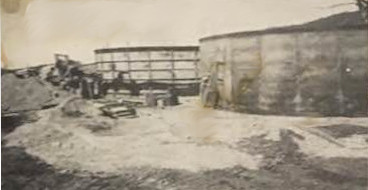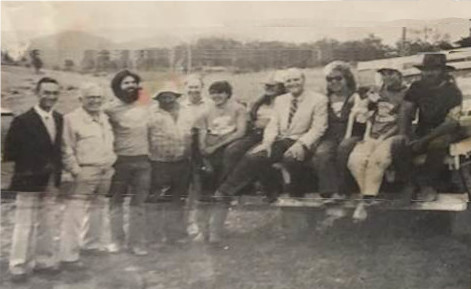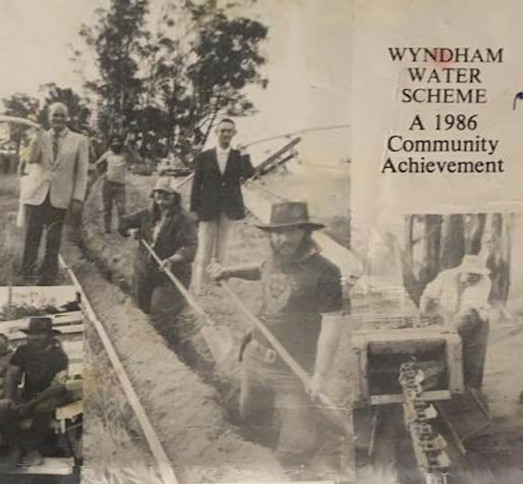A History of the Wyndham Water Scheme
Contributed by Bernie Cornell
Wyndham lies about half an hour from the Merimbula/Pambula coast and is less than three hours from the Snowfields. The small village is situated in the hills near the head of Mataganah & Myrtle Creeks in the Towamba Valley catchment. The farmland here is surrounded by South East Forests National Parks and State Forests, and the town straddles the road that is the main East-West route over Mount Darragh, from the coast to Bombala.
The nearby 'Jingera Rock' is a spectacular and high rocky outcrop, that rises above the surrounding countryside with many changing colours. Towards the summit of Mt. Darragh, a forest of tree ferns and flowering natural vegetation greets every traveler to the Monaro Tableland.
First surveyed in 1856, Wyndham grew into a thriving village by the 1880’s, when the main occupation of its people centred on the dairy industry, mining and on forest work like sleeper cutting, wattle bark stripping and timber for building and fencing.
With the passing of the years the village changed its character. The butter factories closed, modern transport and sealed roads came about, farms were subdivided and work was sought in the nearby larger towns.
Many families have occupied smaller acres seeking a more relaxed life free of the stresses of city life, whilst at the same time minds turned to creating ventures which are designed to improve living conditions.
In 1984 such an occasion arose when the supply of water proved a difficulty in the village. Most homes relied on tank water, while a few pumped water from the Mataganah Creek which ran close to the northern boundary of the village.
About 2.5km away ran the Myrtle Creek which has better quality water and is fairly free of minerals. Both creeks have their source in the nearby mountains, and both empty into the Towamba River. The rainfall in the area is about 850 mm and severe droughts are rare.
Foremost amongst those who were anxious for a guaranteed water supply were the hotel-keeper Bill Pearce, the school principal, Steve Goodchild and the Bega Valley Shire Council, needing water for public places. The school enrolment was 56 and water for toilet and ablution facilities was pumped from Mataganah Ck.
Living close to Myrtle Creek was David Herbert, a retired water engineer who was active in the Wyndham Progress Association and was familiar with the flow of the creek and the quality of the water. He conceived the idea of supplying the village with water from that creek.
The distance from the village and the problem of easements over private land for the pipeline deterred much local support for his idea but his persistence finally paid off, with approval gained for a survey of the local people to gauge support for the idea.
A Progress Association meeting was held in 1984 of all townspeople. This helped to reach the decision that if all households participated in a water scheme it would cost between $200 to $600 each. Around 24 households agreed to participate and each paid $50 for an engineering study to be carried out by David Herbert.
The study began in October of 1984 and by December David Herbert had presented his findings. These included a funding proposal which depended on voluntary labour, a charge of $500 for each member of the scheme to buy materials, plus a bank loan.
The study determined and costed the water requirements, pump, motor, pipeline and reservoir sizes and location and set out the village distribution system, points of supply etc.
Negotiations were needed with several government departments, including NSW Water Resources Commission, which gave permission for a pump on Myrtle Creek. The Lands Department authorised a pipeline to be laid from the creek to the reservoirs 2.2Km away, near the cemetery. The Shire Council allowed the location of a pump beside the road at the Honeysuckle Bridge over Myrtle Creek.
The location of the reservoirs needed to be sufficiently high above the village to provide a gravity supply at a satisfactory pressure.
When all the requirements had been met, an application was made to the local Federal Member of Parliament for a grant of money from the Community Employment Program and also to its Regional Director, Graham Gall. It was estimated that the cost would amount to $70,000.
Following these efforts, the C.E.P. made available $46,500, Westpac Bank made a loan of $10,000, the Dept. of Education offered $5600 as did the Bega Shire Council, leaving a balance which was to be made up by members of the Scheme.

The C.E.P. Grant enabled the seven unemployed men and women, two of them as leading hands and the others as labourers. Bill Pearce obtained a trench digger for digging the pipe-lines which were cleared of stumps and vegetation with a bulldozer driven at no cost by Barry Collins who also did the excavation work for the reservoir tanks.
The scheme was completed on schedule in May 1986 and the working group celebrated at the Robbie Burns Hotel with Federal MP Jim Snow and Westpac manager, Jim Dodd. It remained then for the Illawarra County Council to connect the power for the pumping to begin.
The scheme was operated by the Progress Association until 1990 when the Wyndham Community Water Users was incorporated and took over the running of the scheme.


With the scheme in operation, it became necessary to pay attention to compliance with health regulations and issues of pump maintenance, filtration issues, storage size, disinfection and other maintenance matters became more important. System operation was entirely manual and it became clear that pump automation would be necessary.
High pumping pressures were apparent at connections of members on the rising-main and caused failures, leaks and other issues. This led to the installation of a new branch line direct from the village to supply these members. The ultra-violet disinfection system was upgraded and the filtration was also installed at the creek pump.
A groundwater bore was installed near the pump station in 2004 to augment the creek supply. In 1997 water meters were installed at all members connections to monitor usage and expose leaks and in 2005 a water-usage charge of $1.50/kL was introduced, with a quarterly access subscription of $17.50.
An automated backup power system for the UV disinfection units, that runs during outages was installed. Fire hydrants and overhead fire-truck filling stations were also installed and manual back-washed sand-filter was installed at the pump-station in 2009. Floods in 2011 damaged the creek intake works, which led to the bore being used for a 9 month period, until the bore-pump failed due to the high iron-levels. The bore was abandoned until 2014, when it was rehabilitated and a new pump installed, along with an effective (and expensive) iron removal filter.
By 2014, reservoir storage capacity was 650kL, allowing about 3 weeks supply and a sand filter and activated carbon filter (with automated daily backwashing) was installed.
More recently, new NSW Government regulations for public water supplies, led to the compilation and adoption of a Quality Assurance Program for the scheme, documenting all equipment, guidelines and procedures.
Maintenance of pipelines and equipment, meter reading, daily monitoring of operation and clerical work is carried out by the Association members. Bob Hunt has, for many years, been in attendance to monitor the operation and meet any emergency which arises. His work is invaluable and the villagers are fortunate that he is available.
By 2023 membership reached around 78, with 100 membership units held, including 10 units each for the primary school and the Bega Valley Shire Council. New connections are charged a $6500 capital contribution, as at 2022. Quarterly membership fees are $50 (with a $25 pay-on-time discount) and the water-usage charge is set at at 75% of the Bega Valley Shire Council rate.
The council takes samples of the village water fortnightly for bacterial testing and every 6 months for chemical analysis. If a single e-Coli bacteria is detected in a sample, chlorine disinfectant is added to the reservoir, however this has been unnecessary for the past several years, since strengthening of equipment maintenance regimes has been implimented.
The Wyndham town-water supply supports around 150 people in and around the town, and many others who use village facilities, such as the school, the hall, the public toilets, the sport and recreation areas and especially the overhead fillers and hydrants for firefighting. All depends on the industrious group of people who have given their time and efforts over a long period of time. It can be described as a unique community effort destined to last while there is water available.
Wyndham Water Scheme history of improvements:
1990
- WCWU became an incorporated association.
- A functioning water supply system was in place, consisting of a 10kw multi-stage pump, drawing creek-water directly from spears buried in the sand bed and delivering around 8kL per hour to the reservoirs.
- Water was pumped into two 80kL concrete reservoirs, 2.3 km distant at 80 metres higher in elevation, around 40 metres above the village.
- Reservoir water flowed by gravity to the reticulation network, through 2 small ultra-violet disinfection units, housed in a concrete block shed on Oak Street.
- The UV disinfection units were installed due to Health Department disinfection requirements for public water supplies and the members rejection of chemical additives.
- The high pump-rate of 8kL per hour and the long 2.3Km, 50mm pipe-line, caused high dynamic pumping pressures, leading to over-pressure issues for connections along the pump-line.
- An electronic pump control unit as specified by David Herbert had been installed at the pump-house, but the specified static tank-level monitoring tube up to the tanks had not.
- Attending and manually switching the pump on and off was therefore necessary and so overflowing of tanks or running out of water were fairly common occurrences in the early days.
- With no filtration, sand and detritus from the creek caused high pump maintenance issues and it was also problematic for consumers, with objects such as small snails sometimes coming out of taps.
1991
- A third concrete tank was added (105 K), bringing total storage to 265 kL.
1993
- A wireless telemetry system, based on an adapted pocket paging system, was installed to control the pump automatically, based on 4 discrete tank level float switches.
1994
- Three fire hydrants were installed in the village.
1996
- Agreements for “easements for water supply”with landholders was actively sought over the many parcels of private land through which pipelines had been run without tenure.
- A plot of land in the village (with a large storage shed) was purchased, with the main purpose of having land that could be the legal beneficiary of all of the the pipeline easements.
- As of 2020, only one easement remains to be secured, for a pipeline servicing a single connection .
1997
- A gravity-fed supply augmentation from Myrtle Mountain was approved and as part of this project, a 100 mm water main was laid up the main street,as far as the old police station.
- The gravity feed project was eventually abandoned due to ongoing lack of flow evident at the source..
- A redesigned pumping system was installed, with a single stage pump, able to handle sand, drawing water from a sump in the creek, to fill a new 20kL concrete tank on the higher old roadway level.
- A new pumphouse was also built at this level for a new smaller multi-stage pump, now being fed by positively pressurised water, free of sand.
- The high pump maintenance and pump priming issues were now gone.
- Plumbing leaks at member’s connections were an ongoing problem and water meters were purchased and installed at each connection point, in an effort to identify leaks quantify the issue.
- Member resistance to the installation of water-meters was addressed by specifying that it was for management purposes only.
2002
- The dual 25mm UV disinfection units were upgraded to a larger 50mm unit, with 4 times the flow and the old system kept in place for backup disinfection purposes.
- Upgraded wireless pump-control telemetry was installed for pumping controll and to provide real-time monitoring and recording of pumping parameters and tank-levels.
2004
- A bore was installed near the pump-station and a fourth tank (105kL) was installed, taking the total storage to 370kL.
- A tanker fill-station was installed near the cemetery, on the pump line.
2005
- Data obtained from the water meters installed at member's connections 8 years earlier, indicated large inequalities in members water usage, despite all paying the same flat water rate. There was no financial incentive for members to minimise their water usage or even to repair leaks. .
- A change from the existing flat rating system to one based on member's metered water-usage was suggested as a means to address the inequality and reduce excessive pumping.
- The change to usage-based rating became quite a controversial issue amonst members; one that was resolved by the holding of a referendum, giving all members the chance to cast their vote on the issue by mail.
- The referendum resulted in a 75% member participation rate, with the result 2 to 1 in favour of switching to usage-based rating.
2006
- A water-usage rate of $1.50 per kL was implemented, with a membership subscription of $17.50 per quarter.
2008
- The records show that the introduction of usage-based rating led to a 28% reduction in water usage and pumping.
- A new 800m long 50mm pipeline was installed to provide treated and constant-pressure water to 9 members who were previously connected to the rising-main (pump-line).
- A high-flow overhead filler, designed for fast-filling water-tankers, was installed on the track up to the tanks.
2009
- A manual back-wash sand filter was installed at the pump-station.
- The 50mm UV disinfection unit was replaced with a higher capacity, twin lamp unit, due to numerous bacerial test non-compliance events, thought to be caused by the unit being undersized under high-flow conditions.
- The old 50mm UV unit was installed at the pump-station as an additional disinfection layer for the raw creek-water, operating within it's papacity, at a constant flow-rate.
2011
- A big flood in March took out the creek intake infrastructure.
- The back up bore was used for 9 months, which allowed the rebuilding of the creek intake to take place.
2012
- Consecutive floods and sustained turbid creek-water caused the bore to be used again.
- Hardness of the bore water decreased to within Australian standards but the iron (rust) levels got worse and eventually blew up the bore pump, which led to the bore being abandoned.
- An LPG generator powered uninterruptible power supply was designed, built and installed at the UV shed in order to ensure effective disinfection during power outages.
- A pay on time rates discount was introduced, to encourage members to pay early and reduce admin work.
2014
- Two more concrete tanks were installed (140kL each), bringing total storage to 650kL or about three weeks supply.
- The 10kw 8kL per hour pump was replaced with a smaller 2.2kw 5kL per hour pump, resulting in lower pumping pressures and pumping costs.
- The change to user-pays rating system and the subsequent attention to leaks and excessive usage by members resulted in much reduced water usage allowing pumping rates to be reduced leading to less waste of power on exessive pipefriction losses.
- A sand filter, and an activated-carbon filter, each with automated daily back-wash were installed at the pump-station, along with a UV disinfection unit n the creek-pump.
2016
- A quality Assurance Program was adopted to comply with new legislation
2018/19
- The bore was rehabilitated with a new pump installed, along with a new iron filter unit in order to deal with the high iron content of the bore water.
2021
- Ongoing issues with low flow and iron bacteria clogging of the existing bore led to a decision to look into alternative water sources.
2022
- A new bore was approved and installed on the council road reserve near the intersection of Mount Darragh and Burragate Roads, around 400 metres away from the existing pump station.
- The new bore is in a different aquifer that contains water of high quality and the bore has been shown to provide sufficient flow to supply the town.
- As there is no mains power connection at the new bore site, an air-driven bore pump was installed, which is driven by an air compressor located at the existing creek-side pump-station.
- The new bore installation turned out to be timely, as extreme and protracted wet conditions led to the creek water being unfit for pumping for many months, while the bore remained unaffected.
- A solar powered submersible pump has also been purchased and is intended to be co-located in the new bore, with the air-driven pump.
Information for this article was sourced from:
Steve Goodchild
Vivian Heriot
Bob Hunt
Maurice Wright
Yvonne Umback
Wyndham Progress Association records
My thanks for the help provided.
B. Cornell 11-11-2019.
Updated 2020
